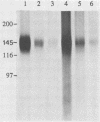Abstract
The Epstein-Barr virus/C3d receptor (EBVR-CR2) was detected on three T-lymphoblastoid cell lines. The apparent Mrs of purified EBVR-CR2 of T-cell and B-cell origin were identical. The N-terminal amino acid sequence from the T-cell EBVR-CR2 confirmed the placement of this receptor in a multigene family of complement regulatory proteins. All EBVR-CR2-positive T-cell lines were T6 and T4-T8 antigen positive.
Full text
PDF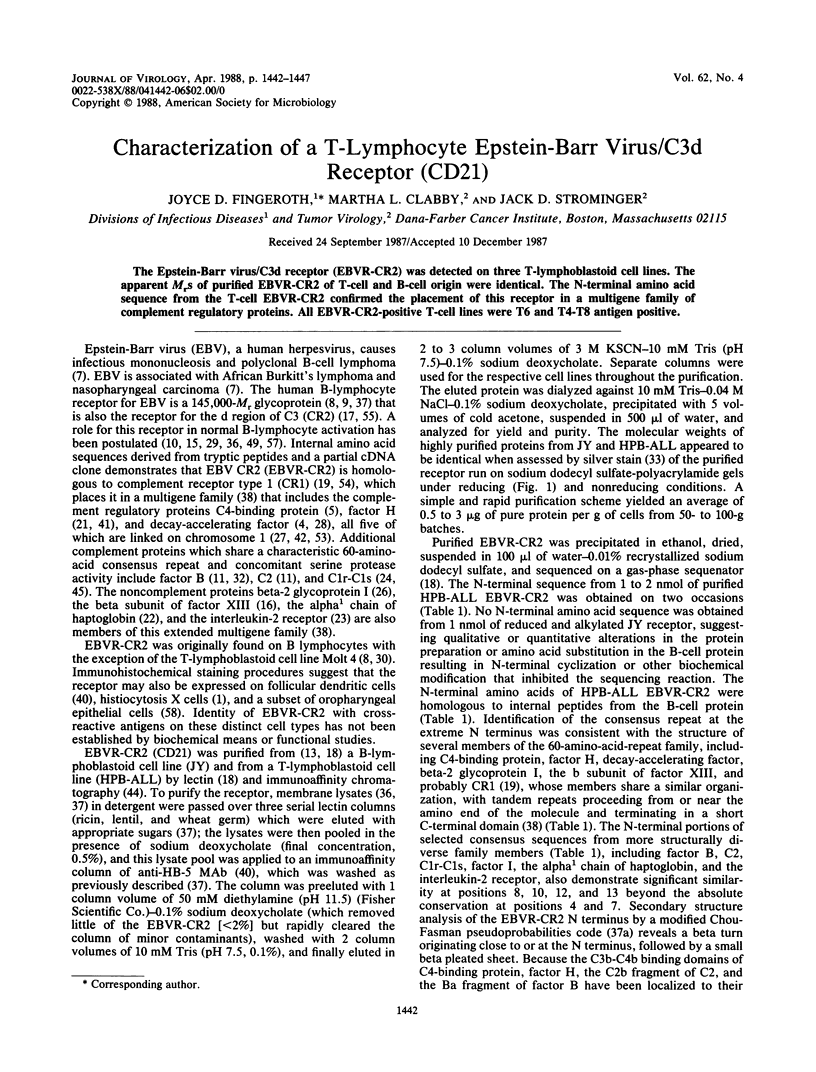
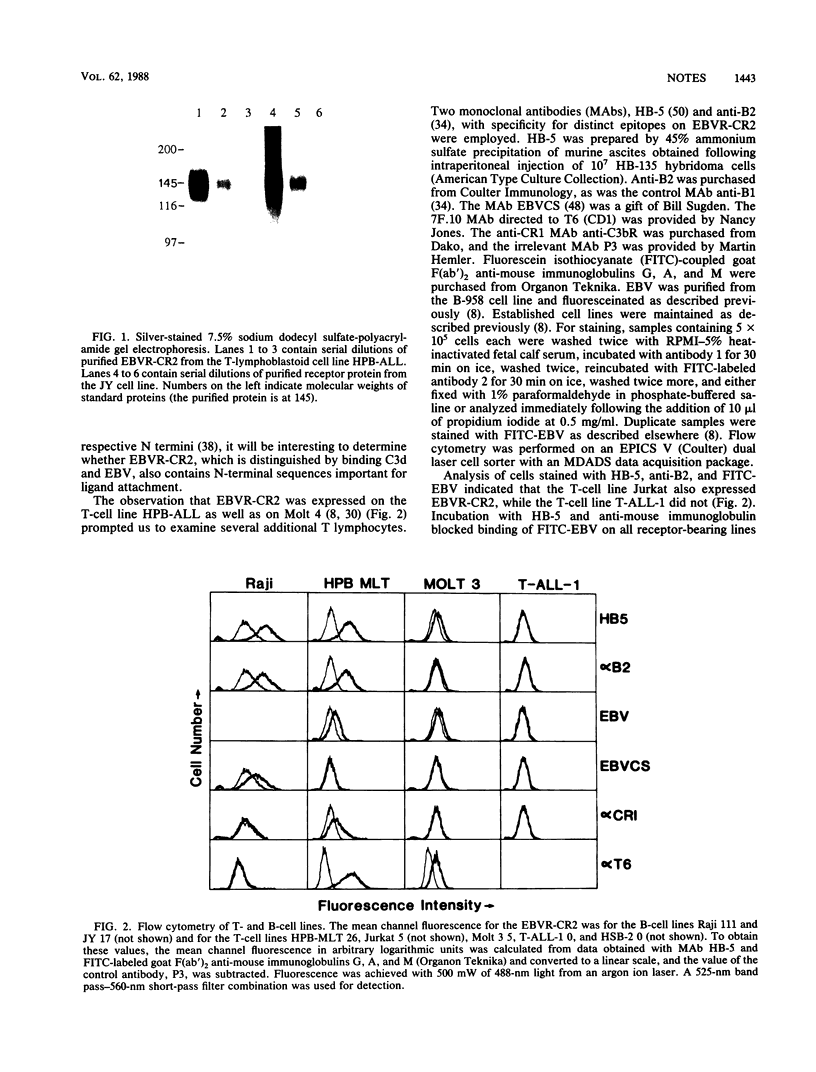
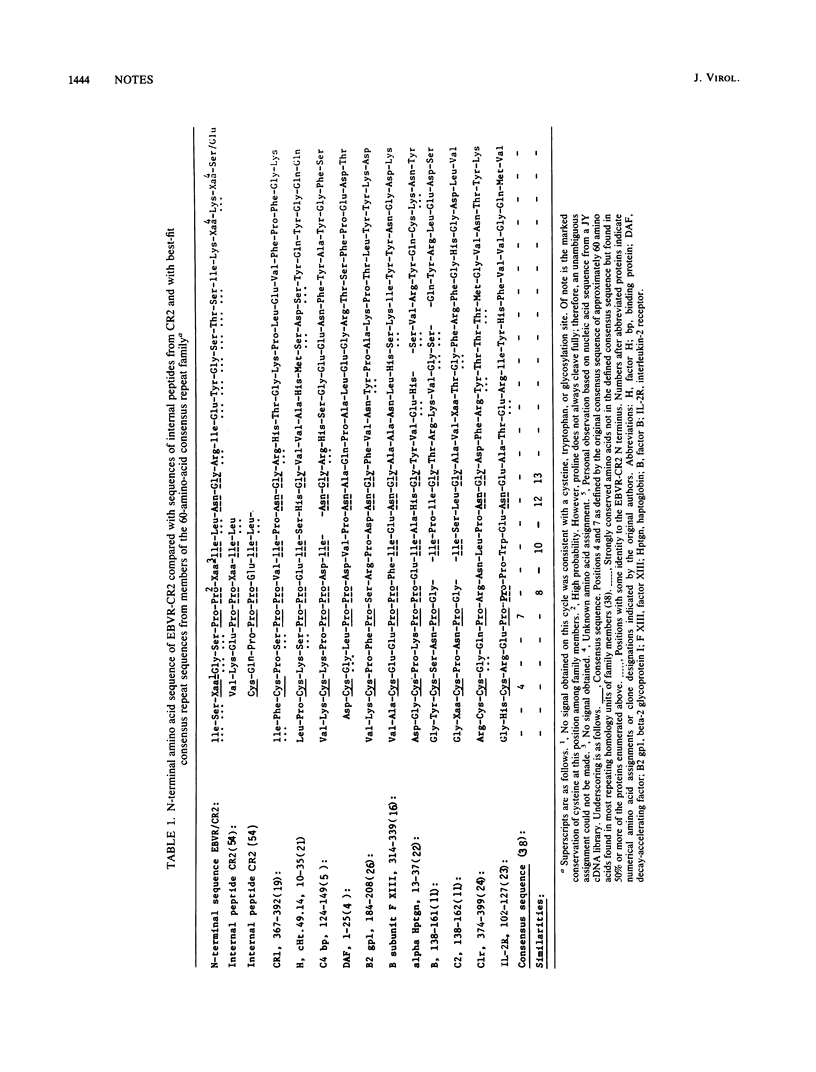
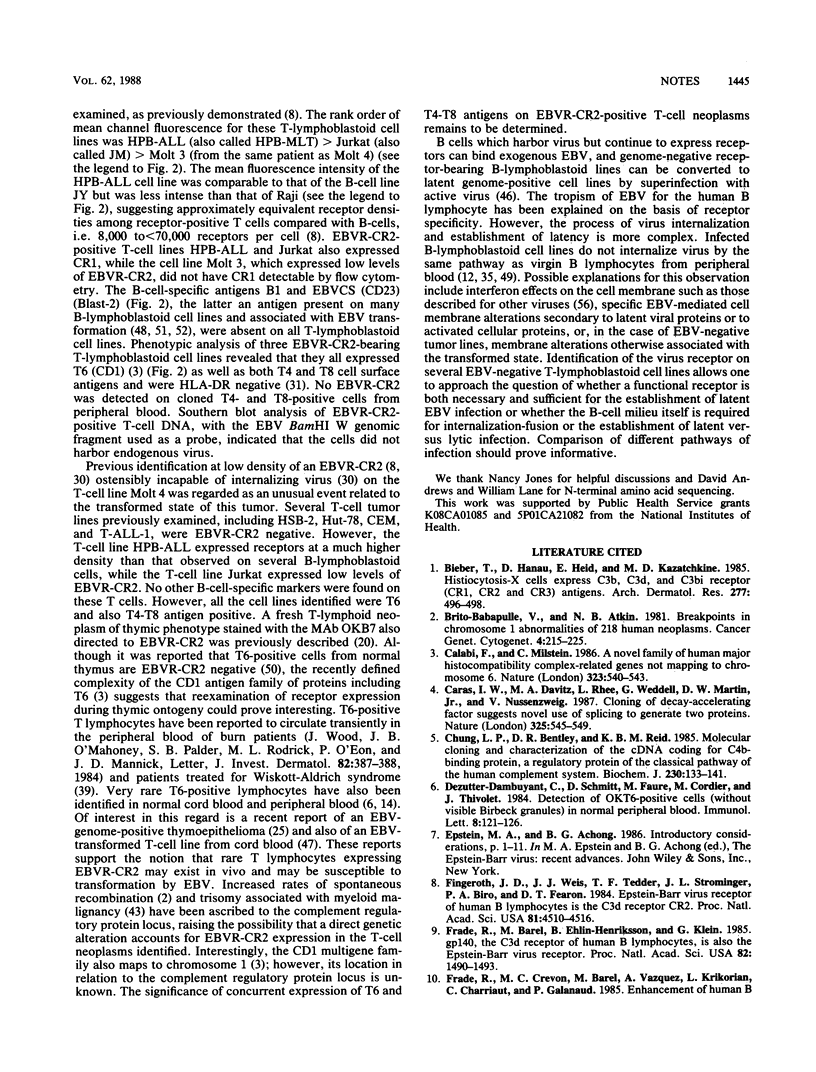
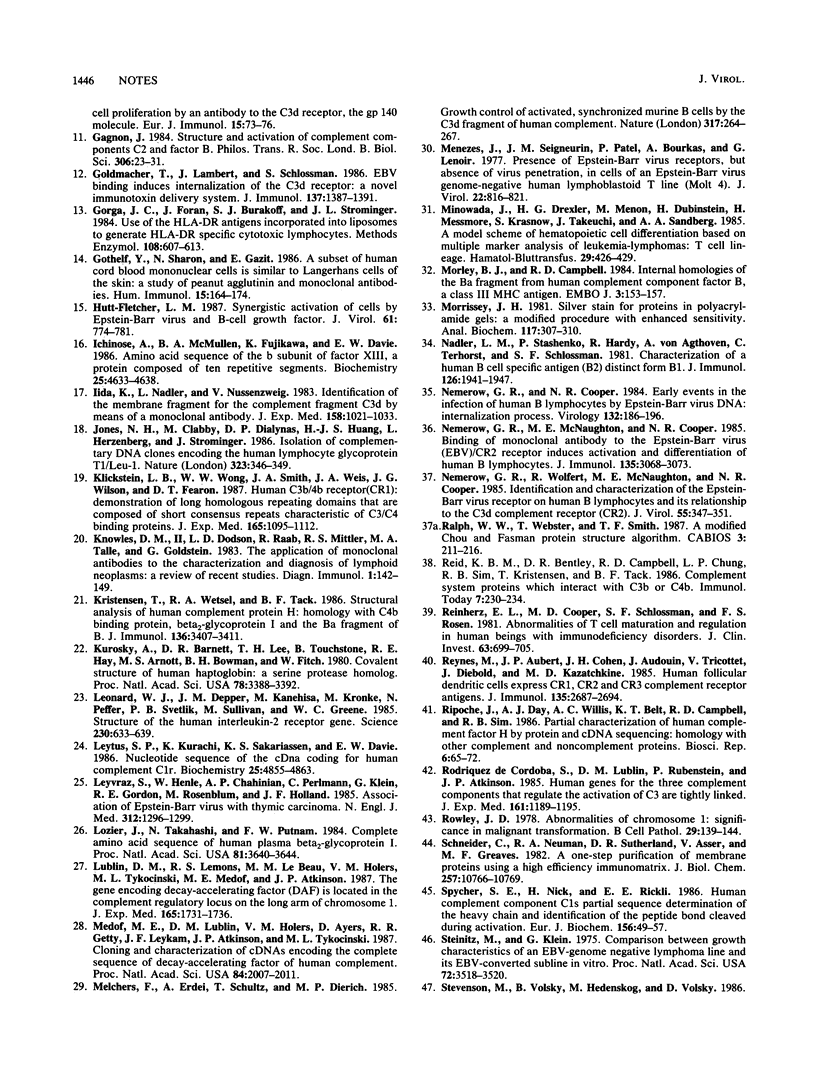
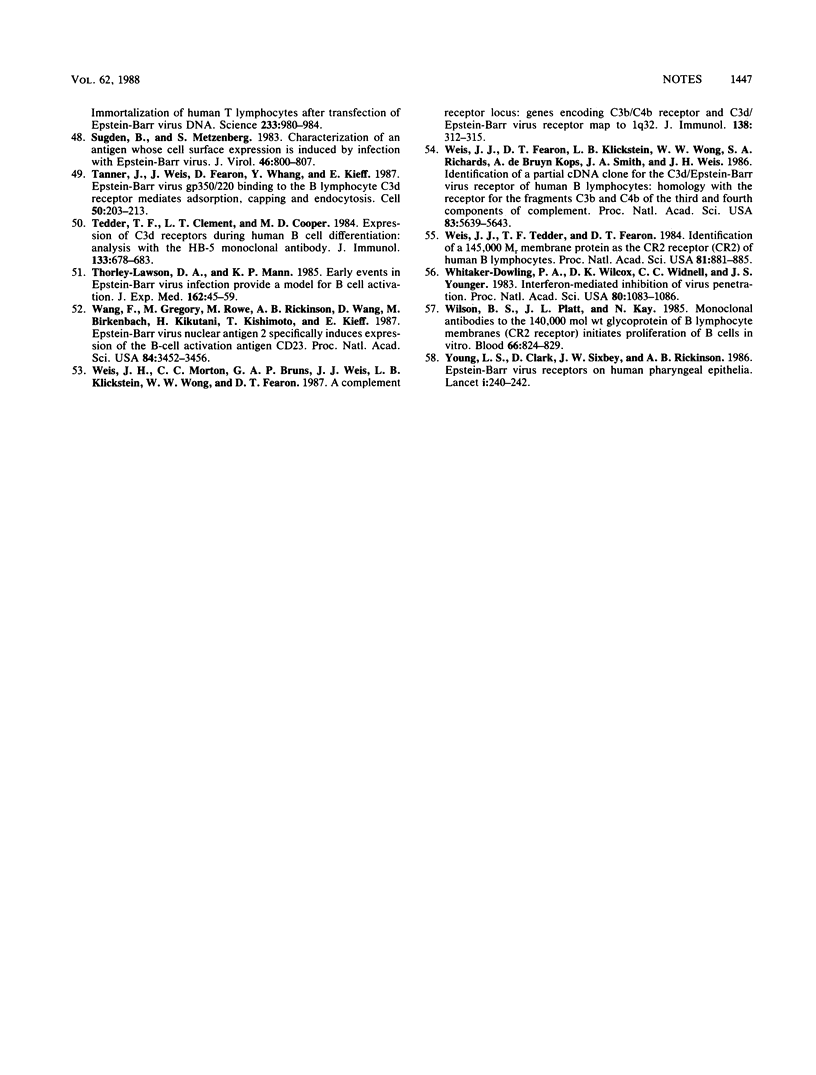
Images in this article
Selected References
These references are in PubMed. This may not be the complete list of references from this article.
- Bieber T., Hanau D., Heid E., Kazatchkine M. D. Histiocytosis-X cells express C3b, C3d, and C3bi receptor (CR1, CR2, and CR3) antigens. Arch Dermatol Res. 1985;277(6):496–498. doi: 10.1007/BF00510069. [DOI] [PubMed] [Google Scholar]
- Brito-Babapulle V., Atkin N. B. Break points in chromosome #1 abnormalities of 218 human neoplasms. Cancer Genet Cytogenet. 1981 Nov;4(3):215–225. doi: 10.1016/0165-4608(81)90015-7. [DOI] [PubMed] [Google Scholar]
- Calabi F., Milstein C. A novel family of human major histocompatibility complex-related genes not mapping to chromosome 6. Nature. 1986 Oct 9;323(6088):540–543. doi: 10.1038/323540a0. [DOI] [PubMed] [Google Scholar]
- Caras I. W., Davitz M. A., Rhee L., Weddell G., Martin D. W., Jr, Nussenzweig V. Cloning of decay-accelerating factor suggests novel use of splicing to generate two proteins. Nature. 1987 Feb 5;325(6104):545–549. doi: 10.1038/325545a0. [DOI] [PubMed] [Google Scholar]
- Chung L. P., Bentley D. R., Reid K. B. Molecular cloning and characterization of the cDNA coding for C4b-binding protein, a regulatory protein of the classical pathway of the human complement system. Biochem J. 1985 Aug 15;230(1):133–141. doi: 10.1042/bj2300133. [DOI] [PMC free article] [PubMed] [Google Scholar]
- Dezutter-Dambuyant C., Schmitt D., Faure M., Cordier G., Thivolet J. Detection of OKT6-positive cells (without visible Birbeck granules) in normal peripheral blood. Immunol Lett. 1984;8(3):121–126. doi: 10.1016/0165-2478(84)90063-4. [DOI] [PubMed] [Google Scholar]
- Fingeroth J. D., Weis J. J., Tedder T. F., Strominger J. L., Biro P. A., Fearon D. T. Epstein-Barr virus receptor of human B lymphocytes is the C3d receptor CR2. Proc Natl Acad Sci U S A. 1984 Jul;81(14):4510–4514. doi: 10.1073/pnas.81.14.4510. [DOI] [PMC free article] [PubMed] [Google Scholar]
- Frade R., Barel M., Ehlin-Henriksson B., Klein G. gp140, the C3d receptor of human B lymphocytes, is also the Epstein-Barr virus receptor. Proc Natl Acad Sci U S A. 1985 Mar;82(5):1490–1493. doi: 10.1073/pnas.82.5.1490. [DOI] [PMC free article] [PubMed] [Google Scholar]
- Gorga J. C., Foran J., Burakoff S. J., Strominger J. L. Use of the HLA-DR antigens incorporated into liposomes to generate HLA-DR specific cytotoxic T lymphocytes. Methods Enzymol. 1984;108:607–613. doi: 10.1016/s0076-6879(84)08121-0. [DOI] [PubMed] [Google Scholar]
- Gothelf Y., Sharon N., Gazit E. A subset of human cord blood mononuclear cells is similar to Langerhans cells of the skin: a study with peanut agglutinin and monoclonal antibodies. Hum Immunol. 1986 Feb;15(2):164–174. doi: 10.1016/0198-8859(86)90024-8. [DOI] [PubMed] [Google Scholar]
- Hutt-Fletcher L. M. Synergistic activation of cells by Epstein-Barr virus and B-cell growth factor. J Virol. 1987 Mar;61(3):774–781. doi: 10.1128/jvi.61.3.774-781.1987. [DOI] [PMC free article] [PubMed] [Google Scholar]
- Ichinose A., McMullen B. A., Fujikawa K., Davie E. W. Amino acid sequence of the b subunit of human factor XIII, a protein composed of ten repetitive segments. Biochemistry. 1986 Aug 12;25(16):4633–4638. doi: 10.1021/bi00364a027. [DOI] [PubMed] [Google Scholar]
- Iida K., Nadler L., Nussenzweig V. Identification of the membrane receptor for the complement fragment C3d by means of a monoclonal antibody. J Exp Med. 1983 Oct 1;158(4):1021–1033. doi: 10.1084/jem.158.4.1021. [DOI] [PMC free article] [PubMed] [Google Scholar]
- Jones N. H., Clabby M. L., Dialynas D. P., Huang H. J., Herzenberg L. A., Strominger J. L. Isolation of complementary DNA clones encoding the human lymphocyte glycoprotein T1/Leu-1. 1986 Sep 25-Oct 1Nature. 323(6086):346–349. doi: 10.1038/323346a0. [DOI] [PubMed] [Google Scholar]
- Klickstein L. B., Wong W. W., Smith J. A., Weis J. H., Wilson J. G., Fearon D. T. Human C3b/C4b receptor (CR1). Demonstration of long homologous repeating domains that are composed of the short consensus repeats characteristics of C3/C4 binding proteins. J Exp Med. 1987 Apr 1;165(4):1095–1112. doi: 10.1084/jem.165.4.1095. [DOI] [PMC free article] [PubMed] [Google Scholar]
- Knowles D. M., 2nd, Dodson L. D., Raab R., Mittler R. S., Talle M. A., Goldstein G. The application of monoclonal antibodies to the characterization and diagnosis of lymphoid neoplasms: a review of recent studies. Diagn Immunol. 1983;1(3):142–149. [PubMed] [Google Scholar]
- Kristensen T., Wetsel R. A., Tack B. F. Structural analysis of human complement protein H: homology with C4b binding protein, beta 2-glycoprotein I, and the Ba fragment of B2. J Immunol. 1986 May 1;136(9):3407–3411. [PubMed] [Google Scholar]
- Kurosky A., Barnett D. R., Lee T. H., Touchstone B., Hay R. E., Arnott M. S., Bowman B. H., Fitch W. M. Covalent structure of human haptoglobin: a serine protease homolog. Proc Natl Acad Sci U S A. 1980 Jun;77(6):3388–3392. doi: 10.1073/pnas.77.6.3388. [DOI] [PMC free article] [PubMed] [Google Scholar]
- Leonard W. J., Depper J. M., Kanehisa M., Krönke M., Peffer N. J., Svetlik P. B., Sullivan M., Greene W. C. Structure of the human interleukin-2 receptor gene. Science. 1985 Nov 8;230(4726):633–639. doi: 10.1126/science.2996141. [DOI] [PubMed] [Google Scholar]
- Leytus S. P., Kurachi K., Sakariassen K. S., Davie E. W. Nucleotide sequence of the cDNA coding for human complement C1r. Biochemistry. 1986 Aug 26;25(17):4855–4863. doi: 10.1021/bi00365a020. [DOI] [PubMed] [Google Scholar]
- Leyvraz S., Henle W., Chahinian A. P., Perlmann C., Klein G., Gordon R. E., Rosenblum M., Holland J. F. Association of Epstein-Barr virus with thymic carcinoma. N Engl J Med. 1985 May 16;312(20):1296–1299. doi: 10.1056/NEJM198505163122006. [DOI] [PubMed] [Google Scholar]
- Lozier J., Takahashi N., Putnam F. W. Complete amino acid sequence of human plasma beta 2-glycoprotein I. Proc Natl Acad Sci U S A. 1984 Jun;81(12):3640–3644. doi: 10.1073/pnas.81.12.3640. [DOI] [PMC free article] [PubMed] [Google Scholar]
- Lublin D. M., Lemons R. S., Le Beau M. M., Holers V. M., Tykocinski M. L., Medof M. E., Atkinson J. P. The gene encoding decay-accelerating factor (DAF) is located in the complement-regulatory locus on the long arm of chromosome 1. J Exp Med. 1987 Jun 1;165(6):1731–1736. doi: 10.1084/jem.165.6.1731. [DOI] [PMC free article] [PubMed] [Google Scholar]
- Medof M. E., Lublin D. M., Holers V. M., Ayers D. J., Getty R. R., Leykam J. F., Atkinson J. P., Tykocinski M. L. Cloning and characterization of cDNAs encoding the complete sequence of decay-accelerating factor of human complement. Proc Natl Acad Sci U S A. 1987 Apr;84(7):2007–2011. doi: 10.1073/pnas.84.7.2007. [DOI] [PMC free article] [PubMed] [Google Scholar]
- Melchers F., Erdei A., Schulz T., Dierich M. P. Growth control of activated, synchronized murine B cells by the C3d fragment of human complement. Nature. 1985 Sep 19;317(6034):264–267. doi: 10.1038/317264a0. [DOI] [PubMed] [Google Scholar]
- Menezes J., Seigneurin J. M., Patel P., Bourkas A., Lenoir G. Presence of Epstein-Barr virus receptors, but absence of virus penetration, in cells of an Epstein-Barr virus genome-negative human lymphoblastoid T line (Molt 4). J Virol. 1977 Jun;22(3):816–821. doi: 10.1128/jvi.22.3.816-821.1977. [DOI] [PMC free article] [PubMed] [Google Scholar]
- Minowada J., Drexler H. G., Menon M., Rubinstein H., Messmore H., Krasnow S., Takeuchi J., Sandberg A. A. A model scheme of hematopoietic cell differentiation based on multiple marker analysis of leukemia-lymphomas: T cell lineage. Haematol Blood Transfus. 1985;29:426–429. doi: 10.1007/978-3-642-70385-0_87. [DOI] [PubMed] [Google Scholar]
- Morley B. J., Campbell R. D. Internal homologies of the Ba fragment from human complement component Factor B, a class III MHC antigen. EMBO J. 1984 Jan;3(1):153–157. doi: 10.1002/j.1460-2075.1984.tb01776.x. [DOI] [PMC free article] [PubMed] [Google Scholar]
- Morrissey J. H. Silver stain for proteins in polyacrylamide gels: a modified procedure with enhanced uniform sensitivity. Anal Biochem. 1981 Nov 1;117(2):307–310. doi: 10.1016/0003-2697(81)90783-1. [DOI] [PubMed] [Google Scholar]
- Nadler L. M., Stashenko P., Hardy R., van Agthoven A., Terhorst C., Schlossman S. F. Characterization of a human B cell-specific antigen (B2) distinct from B1. J Immunol. 1981 May;126(5):1941–1947. [PubMed] [Google Scholar]
- Nemerow G. R., Cooper N. R. Early events in the infection of human B lymphocytes by Epstein-Barr virus: the internalization process. Virology. 1984 Jan 15;132(1):186–198. doi: 10.1016/0042-6822(84)90102-8. [DOI] [PubMed] [Google Scholar]
- Nemerow G. R., McNaughton M. E., Cooper N. R. Binding of monoclonal antibody to the Epstein Barr virus (EBV)/CR2 receptor induces activation and differentiation of human B lymphocytes. J Immunol. 1985 Nov;135(5):3068–3073. [PubMed] [Google Scholar]
- Nemerow G. R., Wolfert R., McNaughton M. E., Cooper N. R. Identification and characterization of the Epstein-Barr virus receptor on human B lymphocytes and its relationship to the C3d complement receptor (CR2). J Virol. 1985 Aug;55(2):347–351. doi: 10.1128/jvi.55.2.347-351.1985. [DOI] [PMC free article] [PubMed] [Google Scholar]
- Ralph W. W., Webster T., Smith T. F. A modified Chou and Fasman protein structure algorithm. Comput Appl Biosci. 1987 Sep;3(3):211–216. doi: 10.1093/bioinformatics/3.3.211. [DOI] [PubMed] [Google Scholar]
- Reinherz E. L., Cooper M. D., Schlossman S. F., Rosen F. S. Abnormalities of T cell maturation and regulation in human beings with immunodeficiency disorders. J Clin Invest. 1981 Sep;68(3):699–705. doi: 10.1172/JCI110305. [DOI] [PMC free article] [PubMed] [Google Scholar]
- Reynes M., Aubert J. P., Cohen J. H., Audouin J., Tricottet V., Diebold J., Kazatchkine M. D. Human follicular dendritic cells express CR1, CR2, and CR3 complement receptor antigens. J Immunol. 1985 Oct;135(4):2687–2694. [PubMed] [Google Scholar]
- Ripoche J., Day A. J., Willis A. C., Belt K. T., Campbell R. D., Sim R. B. Partial characterization of human complement factor H by protein and cDNA sequencing: homology with other complement and non-complement proteins. Biosci Rep. 1986 Jan;6(1):65–72. doi: 10.1007/BF01145180. [DOI] [PubMed] [Google Scholar]
- Rodriguez de Cordoba S., Lublin D. M., Rubinstein P., Atkinson J. P. Human genes for three complement components that regulate the activation of C3 are tightly linked. J Exp Med. 1985 May 1;161(5):1189–1195. doi: 10.1084/jem.161.5.1189. [DOI] [PMC free article] [PubMed] [Google Scholar]
- Rowley J. D. Abnormalities of chromosome No. 1: significance in malignant transformation. Virchows Arch B Cell Pathol. 1978 Nov 17;29(1-2):139–144. doi: 10.1007/BF02899347. [DOI] [PubMed] [Google Scholar]
- Schneider C., Newman R. A., Sutherland D. R., Asser U., Greaves M. F. A one-step purification of membrane proteins using a high efficiency immunomatrix. J Biol Chem. 1982 Sep 25;257(18):10766–10769. [PubMed] [Google Scholar]
- Spycher S. E., Nick H., Rickli E. E. Human complement component C1s. Partial sequence determination of the heavy chain and identification of the peptide bond cleaved during activation. Eur J Biochem. 1986 Apr 1;156(1):49–57. doi: 10.1111/j.1432-1033.1986.tb09546.x. [DOI] [PubMed] [Google Scholar]
- Steinitz M., Klein G. Comparison between growth characteristics of an Epstein--Barr virus (EBV)-genome-negative lymphoma line and its EBV-converted subline in vitro. Proc Natl Acad Sci U S A. 1975 Sep;72(9):3518–3520. doi: 10.1073/pnas.72.9.3518. [DOI] [PMC free article] [PubMed] [Google Scholar]
- Stevenson M., Volsky B., Hedenskog M., Volsky D. J. Immortalization of human T lymphocytes after transfection of Epstein-Barr virus DNA. Science. 1986 Aug 29;233(4767):980–984. doi: 10.1126/science.3016899. [DOI] [PubMed] [Google Scholar]
- Sugden B., Metzenberg S. Characterization of an antigen whose cell surface expression is induced by infection with Epstein-Barr virus. J Virol. 1983 Jun;46(3):800–807. doi: 10.1128/jvi.46.3.800-807.1983. [DOI] [PMC free article] [PubMed] [Google Scholar]
- Tanner J., Weis J., Fearon D., Whang Y., Kieff E. Epstein-Barr virus gp350/220 binding to the B lymphocyte C3d receptor mediates adsorption, capping, and endocytosis. Cell. 1987 Jul 17;50(2):203–213. doi: 10.1016/0092-8674(87)90216-9. [DOI] [PubMed] [Google Scholar]
- Tedder T. F., Clement L. T., Cooper M. D. Expression of C3d receptors during human B cell differentiation: immunofluorescence analysis with the HB-5 monoclonal antibody. J Immunol. 1984 Aug;133(2):678–683. [PubMed] [Google Scholar]
- Tedder T. F., Goldmacher V. S., Lambert J. M., Schlossman S. F. Epstein Barr virus binding induces internalization of the C3d receptor: a novel immunotoxin delivery system. J Immunol. 1986 Aug 15;137(4):1387–1391. [PubMed] [Google Scholar]
- Thorley-Lawson D. A., Mann K. P. Early events in Epstein-Barr virus infection provide a model for B cell activation. J Exp Med. 1985 Jul 1;162(1):45–59. doi: 10.1084/jem.162.1.45. [DOI] [PMC free article] [PubMed] [Google Scholar]
- Wang F., Gregory C. D., Rowe M., Rickinson A. B., Wang D., Birkenbach M., Kikutani H., Kishimoto T., Kieff E. Epstein-Barr virus nuclear antigen 2 specifically induces expression of the B-cell activation antigen CD23. Proc Natl Acad Sci U S A. 1987 May;84(10):3452–3456. doi: 10.1073/pnas.84.10.3452. [DOI] [PMC free article] [PubMed] [Google Scholar]
- Weis J. H., Morton C. C., Bruns G. A., Weis J. J., Klickstein L. B., Wong W. W., Fearon D. T. A complement receptor locus: genes encoding C3b/C4b receptor and C3d/Epstein-Barr virus receptor map to 1q32. J Immunol. 1987 Jan 1;138(1):312–315. [PubMed] [Google Scholar]
- Weis J. J., Fearon D. T., Klickstein L. B., Wong W. W., Richards S. A., de Bruyn Kops A., Smith J. A., Weis J. H. Identification of a partial cDNA clone for the C3d/Epstein-Barr virus receptor of human B lymphocytes: homology with the receptor for fragments C3b and C4b of the third and fourth components of complement. Proc Natl Acad Sci U S A. 1986 Aug;83(15):5639–5643. doi: 10.1073/pnas.83.15.5639. [DOI] [PMC free article] [PubMed] [Google Scholar]
- Weis J. J., Tedder T. F., Fearon D. T. Identification of a 145,000 Mr membrane protein as the C3d receptor (CR2) of human B lymphocytes. Proc Natl Acad Sci U S A. 1984 Feb;81(3):881–885. doi: 10.1073/pnas.81.3.881. [DOI] [PMC free article] [PubMed] [Google Scholar]
- Whitaker-Dowling P. A., Wilcox D. K., Widnell C. C., Youngner J. S. Interferon-mediated inhibition of virus penetration. Proc Natl Acad Sci U S A. 1983 Feb;80(4):1083–1086. doi: 10.1073/pnas.80.4.1083. [DOI] [PMC free article] [PubMed] [Google Scholar]
- Wilson B. S., Platt J. L., Kay N. E. Monoclonal antibodies to the 140,000 mol wt glycoprotein of B lymphocyte membranes (CR2 receptor) initiates proliferation of B cells in vitro. Blood. 1985 Oct;66(4):824–829. [PubMed] [Google Scholar]
- Young L. S., Clark D., Sixbey J. W., Rickinson A. B. Epstein-Barr virus receptors on human pharyngeal epithelia. Lancet. 1986 Feb 1;1(8475):240–242. doi: 10.1016/s0140-6736(86)90776-2. [DOI] [PubMed] [Google Scholar]



